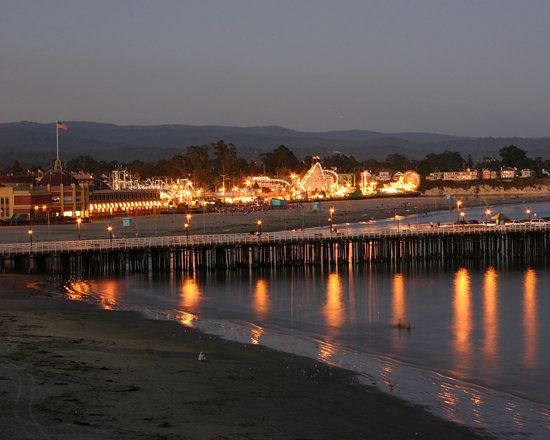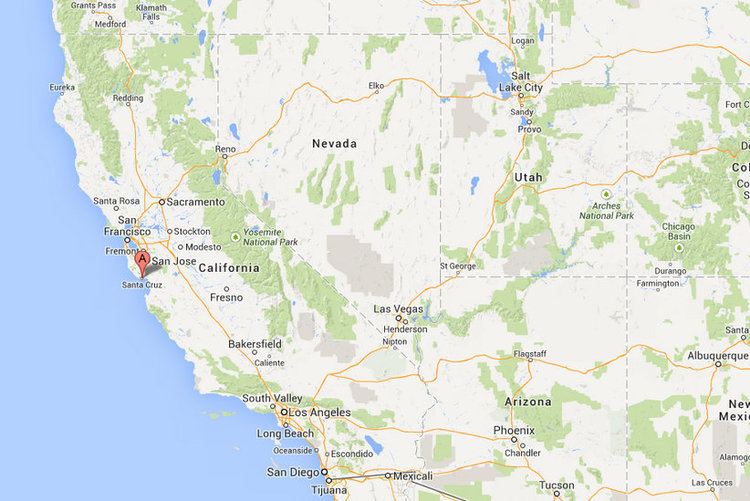Country Population 62,864 (2013) Unemployment rate 8.8% (Feb 2015) Area 15.828 sq mi | State Mayor Don Lane | |
Points of interest Santa Cruz Beach Boardwalk, Natural Bridges State Beach, Wilder Ranch State Park, Mystery Spot, Santa Cruz Wharf Colleges and Universities University of California - Santa Cruz, Five Branches University, Universidad Catolica Boliviana, College Eight, Merrill College | ||
Santa Cruz ( Spanish: ) is the county seat and largest city of Santa Cruz County, California. As of 2013 the U.S. Census Bureau estimated Santa Cruzs population at 62,864.
Contents
- Map of Santa Cruz California
- Santa cruz california
- Santa cruz ranch california rv resort and campground
- History
- Geography
- Economy
- Tourism
- Pop culture references
- Thai food lunch sabieng restaurant santa cruz california usa mp4
- References
Map of Santa Cruz, California
Situated on the northern edge of Monterey Bay, about 32 mi (51 km) south of San Jose and 75 mi (120 km) south of San Francisco, the city is part of the 12-county San Jose-San Francisco-Oakland Combined Statistical Area.
Santa cruz california
Santa Cruz is known for its moderate climate, the natural beauty of its coastline, redwood forests, alternative community lifestyles, and socially liberal leanings. It is also home to the University of California, Santa Cruz, a premier research institution and educational hub, as well as the Santa Cruz Beach Boardwalk, an oceanfront amusement park operating continuously since 1907.
Santa cruz ranch california rv resort and campground
The present-day site of Santa Cruz was the location of Spanish settlement beginning in 1791, including Mission Santa Cruz and the pueblo of Branciforte. Following the Mexican–American War of 1846–48, California became the 31st state in 1850. The City of Santa Cruz was incorporated in 1866 and chartered in April 1876. Important early industries included lumber, gunpowder, lime and agriculture. Late in the 19th century, Santa Cruz established itself as a beach resort community.
History
Prior to the arrival of Spanish soldiers, missionaries and colonists in the late 18th century, the Santa Cruz area was home to the Ohlone Native Americans. The Ohlone had no written language, and lived in small villages scattered around the Monterey Bay and San Francisco Bay regions. Within fifty years of the Spaniards arrival, the Ohlone culture and way of life had virtually disappeared in the Santa Cruz area. The only remnants of their spoken language are three local place names: Aptos, Soquel and Zayante.
Geography
According to the United States Census Bureau, the city covers an area of 15.8 square miles (41 km2), of which 12.7 square miles (33 km2) is land, and 3.1 square miles (8.0 km2) (19.51%) is water.
Economy
The principal industries of Santa Cruz are agriculture, tourism, education (UCSC) and high technology. Santa Cruz is a center of the organic agriculture movement, and many specialty products as well as housing the headquarters of California Certified Organic Farmers. Tourist attractions include the classic Santa Cruz Beach Boardwalk on the beach, the redwood forests in the Santa Cruz Mountains above the town, and Monterey Bay, which is protected as a marine sanctuary.
Tourism
By the 1860s, Pacific Avenue had become the main street of downtown Santa Cruz, and remains so today. Local architect Kermit Darrow and landscape architect Roy Rydell were engaged in 1969 to convert several blocks of Pacific Avenue into a semi-pedestrian street named the Pacific Garden Mall. The Loma Prieta earthquake of 1989 destroyed nearly all of the 19th-century buildings in the downtown area. After the earthquake, the Pacific Garden Mall theme was eliminated, and an updated downtown design plan by ROMA Design Group was implemented. As of 2012, only one empty lot remains on Pacific Avenue from the destruction of the 1989 earthquake.

Downtown Santa Cruz houses a variety of storefronts and businesses, ranging from local coffee shops such as Santa Cruz Coffee Roasting and Verve Coffee Roasters, to corporate retailers such as Forever 21 and Urban Outfitters. It is also stage to many street performers, musicians, and artists, oftentimes creating the presence of background music and miscellaneous street side entertainment when visiting downtown. Consequently, Pacific Avenue serves as an outlet for the artistic and unique culture that Santa Cruz possesses.
Pop culture references

